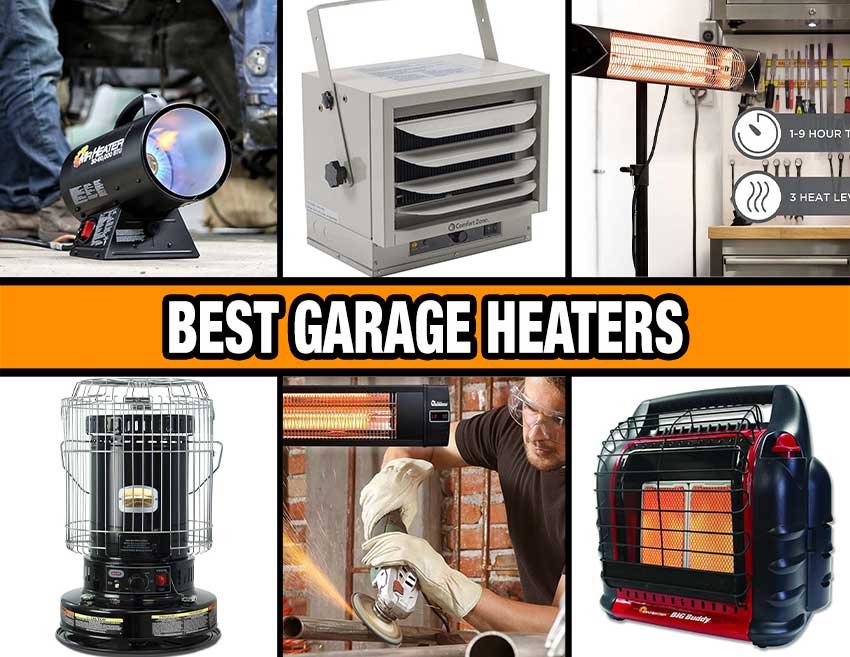
Cold weather has a knack for shutting us in our homes, keeping us from the projects and repairs that we love to (or have to) complete. However, a garage heater is one of the best ways to combat those frigid temps and get to work no matter how low the mercury drops.
That said, every garage is different, as are each person’s needs, so finding the right solution for your setup can be quite a task. But our Best Garage Heater Reviews guide will make things a lot easier. In addition to providing a detailed breakdown of our top picks for 2024, we cover everything from model types and pricing to fuel options, size requirements, and important energy considerations. Our goal is to help you find exactly what you need, buy with confidence, and get the most out of your new heater–and your garage!
Also in this Article
Related Content
How We Picked the Best Garage Heaters
We know how serious garage climate control can be. Whether it’s a space for watching the game or a full-fledged DIY workshop, garage dwellers need to be comfortable to make the most of their space. That’s why we put together all of our experience with garage heaters to come up with the most common types of garage heaters as well as the most important features so we know where to start.
Once we knew what to look for in a garage heater, we came up with a pool of the best-rated garage heaters. We performed extensive product research and drew upon our personal experience with many of the following models to come up with a test pool. We then compared them based on our past experiences, their prices, their features, and other indicators of value. Those that didn’t offer enough value were removed, while those that did were given a spot on our list of the best garage heaters.
Best Overall Garage Heater
Comfort Zone CZ220
For smaller garage workshops, the Comfort Zone CZ220 garage heater is a great choice. This model mounts to the ceiling to keep it up and out of the way, but it has adjustable louvers and an adjustable bracket, both of which enable users to pinpoint heat distribution. It runs on electricity and needs to be hardwired into a 208 to 240-volt electrical circuit.
This model has three heat output settings: 3,000, 4,000, and 5,000 watts, producing a maximum of 17,070 BTU. There is a built-in fan that draws cool air from the rear of the fan and pushes it across the coil to quickly heat a space. The CZ220 also has a simple control panel that allows users to quickly turn the unit on and off and set the temperature, though it doesn’t have any smart features or timers. It has an overheat detection switch that will shut the unit down if the temperature gets dangerously high.
Key Features
- The ceiling-mounted design keeps the unit safely up off the floor and out of the way
- Control panel is very simple and easy to use
- Adjustable angle and adjustable louvers to pinpoint heat
Specifications
- Type: Electric, forced air
- Size: Up to 17,070 BTU
- Safety Features: Overheat protection
Price: $147.69
Best Propane Garage Heater
Mr. Heater 60,000 BTU Portable Propane Forced Air Heater MH60QFAV
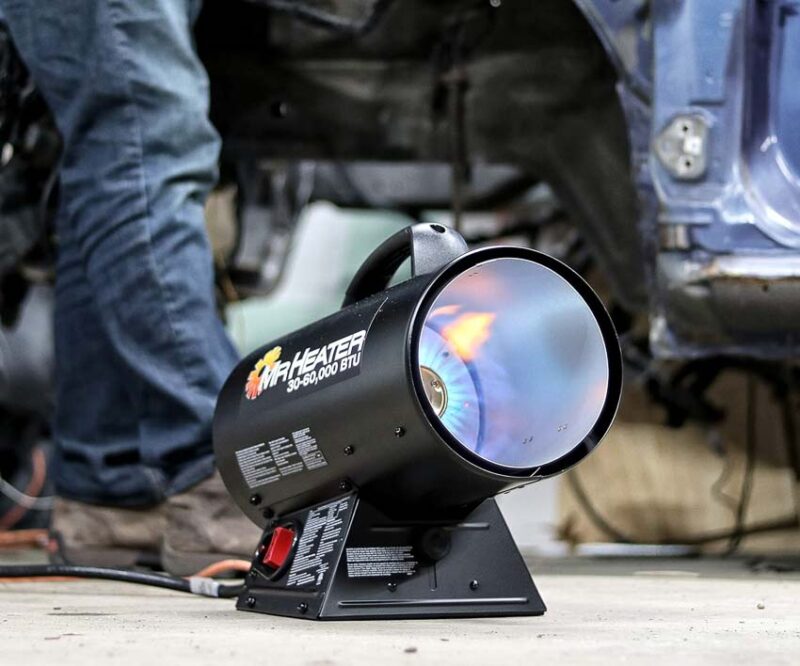
Mr. Heater’s 60,000 BTU Propane Heater is one of the best garage propane heaters for cold shops that need to heat up in a hurry. This is a forced air heater with a fan that pushes heat through the burner, quickly pumping heat into a garage. It has a continuous ignition that will begin lighting the heater as soon as it’s plugged in for easy starting without a Piezo igniter.
Forced air heaters are notoriously loud, but Mr. Heater designed this one to be quieter. It also comes with a 10-foot hose with a regulator, and it features overheat protection that shuts the unit down when it becomes dangerously hot.
Key Features
- Up to 60,000 BTU of heat from a compact heater
- Runs quieter than most propane heaters
- Continuous ignition makes it easy to start
Specifications
- Type: Propane and electric, forced air
- Size: 30,000 to 60,000 BTU
- Safety Features: Overheat protection
Price: $131.39
Best Kerosene Garage Heater
Dyna-Glo 23,800 BTU Indoor Kerosene Convection Heater WK24BK
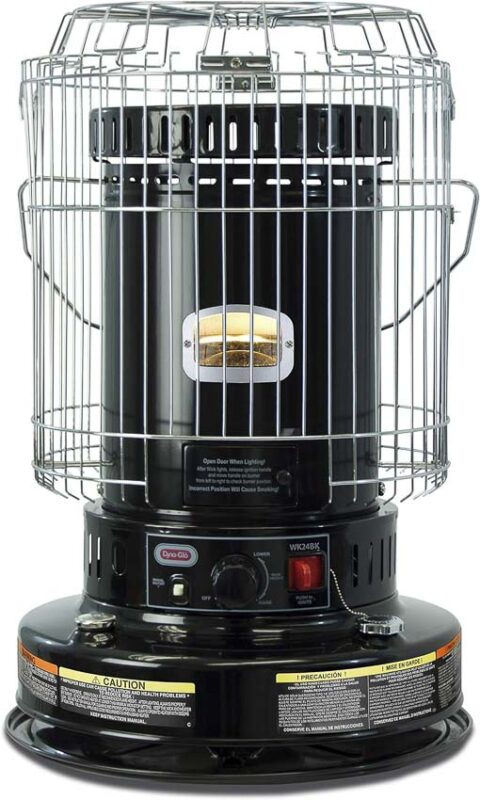
Folks who want to hear their workshop or hang out with kerosene will find the Dyna-Glo WK24BK to be one of the best kerosene heaters for garage spaces. This model produces 23,800 BTUs, allowing it to heat garages as large as 1,000 square feet. It’s 99.9% efficient, which means that it burns cleanly enough to be used inside, making it a solid choice for garage heat. That also allows it to run for up to 12 hours on 1.9 gallons of kerosene.
While kerosene heaters have a reputation for being unsafe, this model has some things going for it. First, it has a safety guard around the heater which should prevent accidental contact. It also has a cool-top design for safety, and if it should be tipped over, the automatic tip-over switch will shut it down. It also has an automatic start and a one-touch shut-off switch for convenience.
Key Features
- Heats up to 1,000 square feet of garage space
- 99.9% efficient so it’s safe for indoor use
- Runs for up to 12 hours on 1.9 gallons of kerosene
Specifications
- Type: Kerosene, convection
- Size: 23,800 BTU
- Safety Features: Safety grille, cool-top design, and tip-over switch
Price: $183.99
Best Natural Gas Garage Heater
Mr. Heater Big Maxx Natural Gas Unit MHU50NG
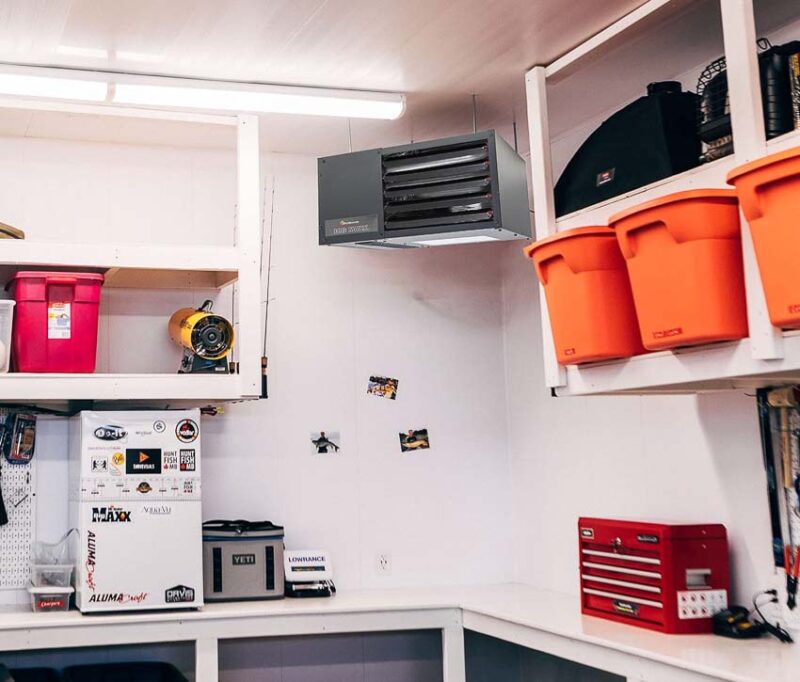
Garages lucky enough to have natural gas access could do well with the Mr. Heater Big Maxx 50,000-BTU garage heater. This natural gas-powered model produces up to 50,000 BTUs of heat, and the high-velocity fan pushes heated air into the space quickly and efficiently. It can heat spaces up to 1,667 square feet.
The Big Maxx is compatible with WiFi or standard thermostats. It also features a self-diagnosing spark ignition system that ensures the heater is running properly. Another point worth noting is that while it does come set for natural gas, it also comes with the propane conversion kit.
Key Features
- Produces 50,000 BTU on natural gas, yet is relatively compact
- High-velocity fan pushes warmth throughout the room.
- Self-diagnosing spark ignition to ensure it’s running properly
- Compatible with WiFi or digital thermostats
Specifications
- Type: Natural gas, forced air
- Size: 50,000 BTU
- Safety Features: None mentioned
Price: $539.99
Best Infrared Garage Heater
Dr Infrared Heater Carbon Infrared Heater DR-238
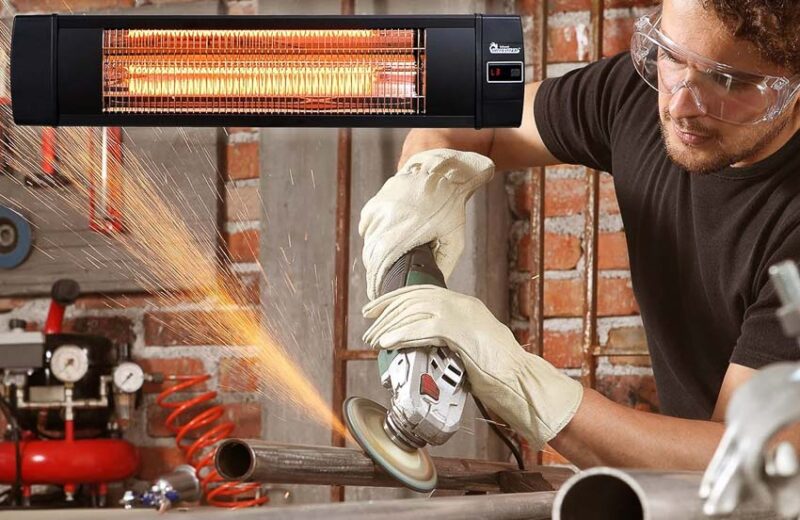
Infrared heat can be a great option for garages, as it heats the objects and people in the space rather than the air around it. This Dr. Infrared Heater can be used to heat the tools, workbench, and other objects in the area, keeping the user comfortable as they work.
The DR-238 can be mounted overhead or on a wall with the included installation brackets. It also uses 120-volt electricity, making it easy to install anywhere there is a suitable outlet. It comes with a remote for easy adjustments as well.
Key Features
- Ceiling or wall-mounted bracket for safe installation
- Heats objects in the space rather than the air around it, which can be ideal in garages
- Uses standard 120v electricity for easy installation
Specifications
- Type: Electric, infrared
- Size: 1,500 watts (roughly 5,200 BTU)
- Safety Features: None mentioned
Price: $105.99
Best Portable Garage Heater
Mr. Heater Big Buddy Pro Series Propane Heater MH18B
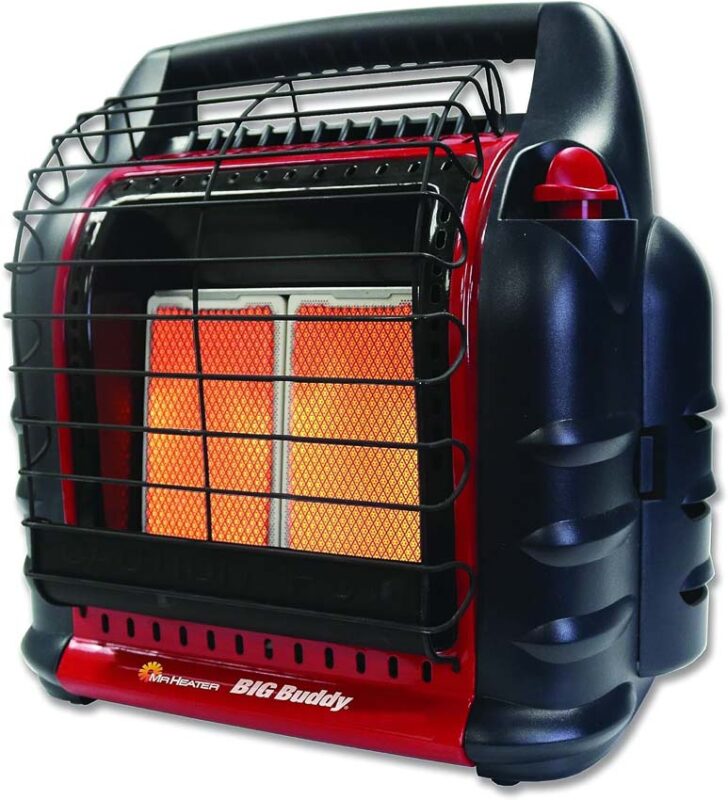
Mr. Heater’s Big Buddy Pro Series Propane Heater is a great choice for occasional repairs in the garage. This portable propane heater accepts two 1-pound propane tanks and can run up to 11 hours on the low setting. It has a top-mounted handle for easy transport, allowing users to place it on a shelf for storage and easily place it on the ground when it’s time to heat.
This model from Mr. Heater has several safety features. First, burns propane very efficiently, making it safe enough for indoor use. It also features a low-oxygen sensor that shuts it off when there isn’t enough oxygen to support a flame. The tip-over switch and flame retardant construction materials also ensure it’s safe in a garage space.
Key Features
- Runs extremely efficiently making it safe for indoors
- Heats smaller garages up to 450 square feet
- Multiple built-in safety features to ensure safe operation
Specifications
- Type: Propane, convection
- Size: 18,000 BTU
- Safety Features: High efficiency, low oxygen sensor, tip-over switch, flame retardant material
Price: $119.99
Best Heater for Garage Gym
Briza Infrared Electric Heater
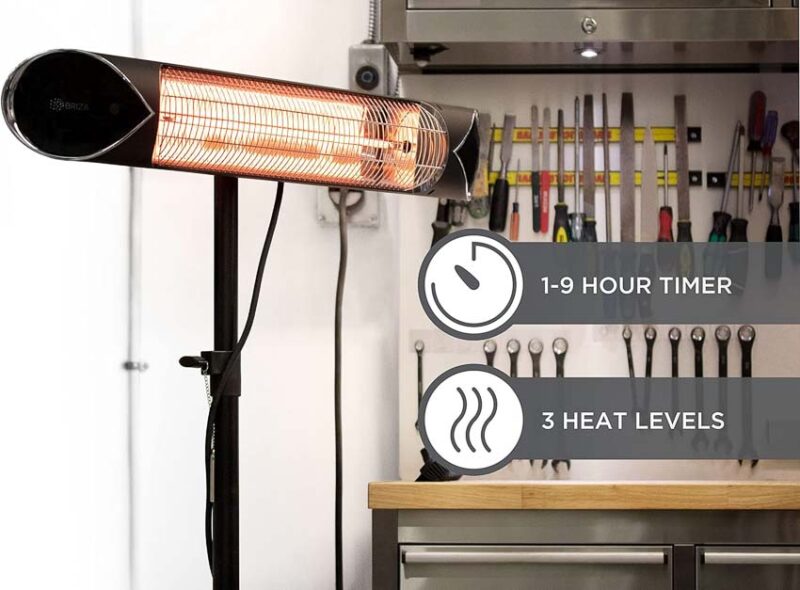
Briza’s Infrared Electric Heater can handle heating duties for a garage-based home gym. This infrared heater will warm the equipment in the space, rather than the air, providing comfortable workout conditions. It features three settings, including 900, 1,200, and 1,500 watts for roughly up to 5,200 BTUs. It can also be mounted to a wall, a ceiling, or the included tripod.
This model comes with a remote for turning it on and off and adjusting the output. It can also program the Briza’s timer, ensuring that the unit shuts off after your workout, even if you forget. Finally, it’s lightweight and easy to position on the tripod, meaning users can position it wherever their workout of the day takes them in the garage space.
Key Features
- Infrared design can heat the equipment in the space for comfortable exercising conditions
- Mounts on wall or ceiling for convenience, but also comes with a tripod for heating a variety of workout spaces
- Remote makes it easy to turn on and off and the timer ensures it will shut off, even if you forget after your workout
Specifications
- Type: Electric, infrared
- Size: 1,500 watts (roughly 5,200 BTU)
- Safety Features: Tip-over switch
Price: $198.50
Best-Selling Garage Heaters
When it comes to tools like garage heaters, finding the best one for your needs depends on a host of variables. That said, your decision will inevitably come down to personal preference and comfort level (both technical and financial). So, in addition to the models that made our list, here are some best-selling alternatives from leading retailers.
Best-Sellers at Acme Tools
Amazon
Lowe’s
Home Depot
Best Garage Heater Buying Guide
There are lots of reasons and ways to heat a garage space, so choosing the right garage heater takes some important consideration. The following are the most important things to know about choosing the best heaters for a garage.
Heating Capacity and Available Space
Determining BTU Requirements
Some scientific calculations can help shoppers size the perfect garage heater for their space. But they’re complicated and, unless you know your insulation value, not a lot of help. Here’s a quick guide to BTU requirements:
| Garage Size | Recommended BTU |
| 1-Car | 15,000 to 25,000 BTU |
| 2- to 2.5-Car | 30,000 to 45,000 BTU |
| 3-Car | 45,000 to 60,000 BTU |
Considering Space Constraints
Garages aren’t always as spacious as we’d like to think they are. Toolboxes, cabinets, and other items often get in the way, so it’s important to consider your garage’s space constraints. Also, models that mount to the ceiling are very handy for keeping the floor clear, but they need to be close enough to an outside wall to vent (gas models), not obstruct any overhead doors, and, ideally, not get in the way when carrying sheets of plywood or other items from workstation to workstation in a garage shop.
Types of Garage Heaters
Electric Heaters
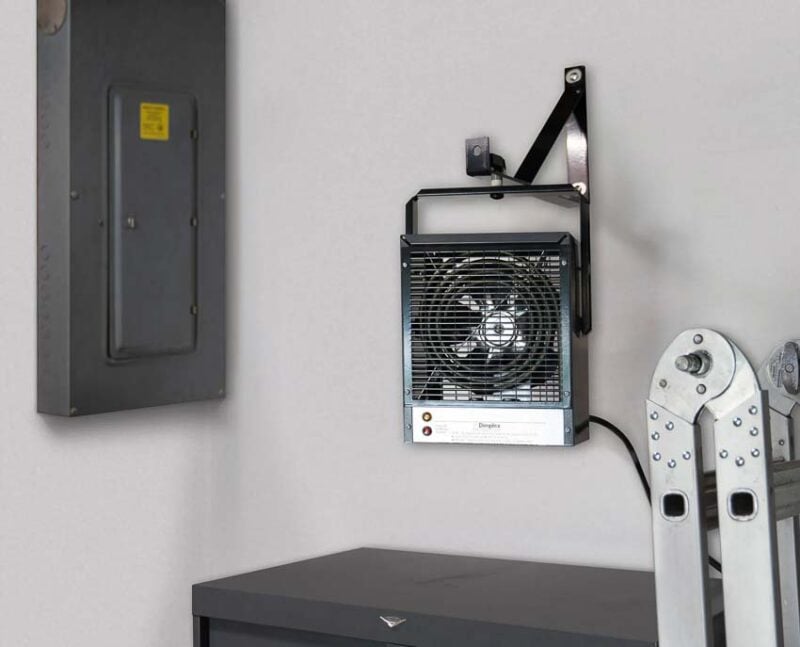
Some garage heaters use the home’s electrical power to heat the space. Depending on the type, they may use 120V, 208V, 240V, 277V, or even 480V electrical circuits to heat their coils or infrared elements. Some might be portable and sit on the floor, while others need to be installed on the wall or ceiling with brackets. Regardless, these units are typically quiet and don’t require venting to the outside.
Propane and Gas Heaters
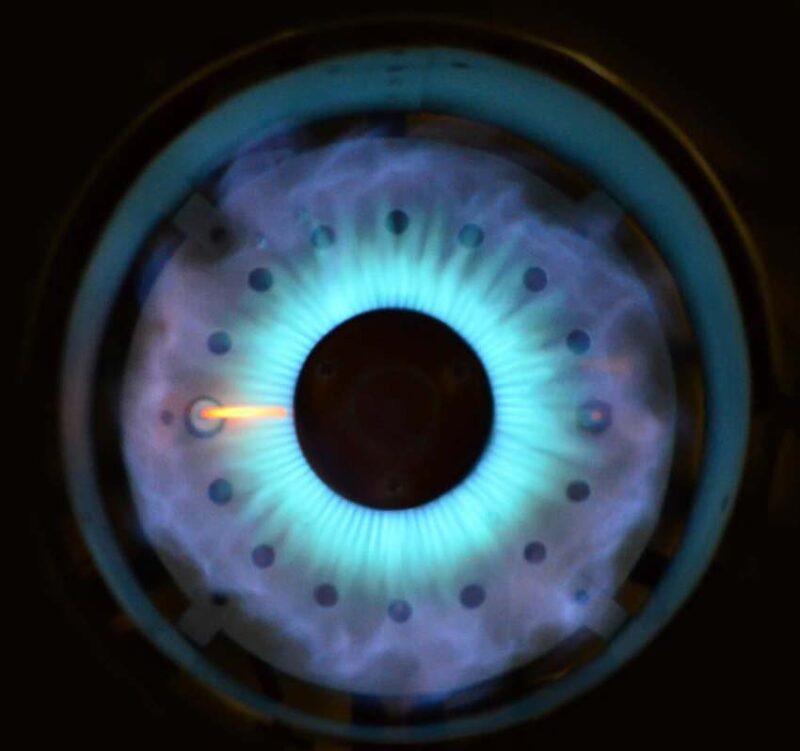
Propane and gas heaters use combustible gasses to produce heat. Natural gas can be piped directly to the heater, while a propane heater requires a bottle or tank outside that is attached to the heater inside. Kerosene is also a popular combustible fuel source, though it’s a liquid rather than a true gas.
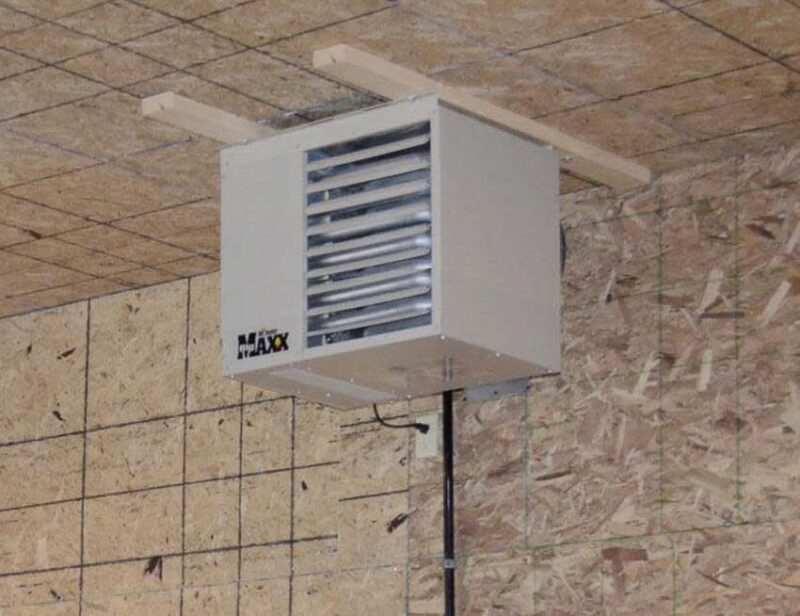
Like electric garage heaters, the best gas garage heaters come in portable and permanent models. Natural gas models are permanently affixed to the wall and ceiling due to their plumbing requirements and vents. The best propane heaters for garage spaces can be portable or permanently mounted. Kerosene heaters are usually portable. In any case, it’s important to check these heaters’ ventilation requirements, as some burn so efficiently that they’re safe to use inside, while others need ventilation to be safe and prevent carbon monoxide poisoning.
Heat Types and Efficiency
Regardless of the fuel source, garage heaters also come in a few varieties:
| Heating Method | Description |
| Forced Air | These feature fans that draw cold air through the back of the heater and push it across a coil or burner. |
| Infrared | A type of heater that warms the objects in the room until they can radiate heat on their own. |
| Convection | These garage heaters radiate heat, producing warm air that rises and pushes down cold air, and then continues the cycle. |
Evaluating Energy Consumption
Garage heaters aren’t known for being energy efficient. The spaces they heat require a lot of output, which requires a lot of fuel consumption. But experts don’t always agree on what fuel source is most efficient. Some claim electric heaters tend to be more efficient while others state natural gas and propane are better.
However, it’s generally accepted that the best garage space heaters for homes with natural gas will take advantage of this clean, efficient fuel source.
Choosing Energy-Saving Models
Some of the best heaters for a garage in winter may have energy-saving features that can help minimize the fuel bill or prevent running out to refill propane tanks every other day. Many have low-temperature settings that allow them to keep a garage above freezing temperatures without heating the space to 55 or 60 degrees. Others might feature programmable timers that users can set to turn the heater on when they’re likely to be in the garage and otherwise keep them off.
Installation and Operation
Installation Requirements
Garage heater installation varies based on the model chosen. For instance, you can take a portable unit out of the box, set it on the floor, turn it on, and you’re in business. Meanwhile, others require more effort, such as ceiling-mounted models, which use brackets attached to the framework or concrete.
Heaters that run on natural gas are even more involved, as they require plumbing and proper ventilation outlets.
User-Friendly Controls and Functions
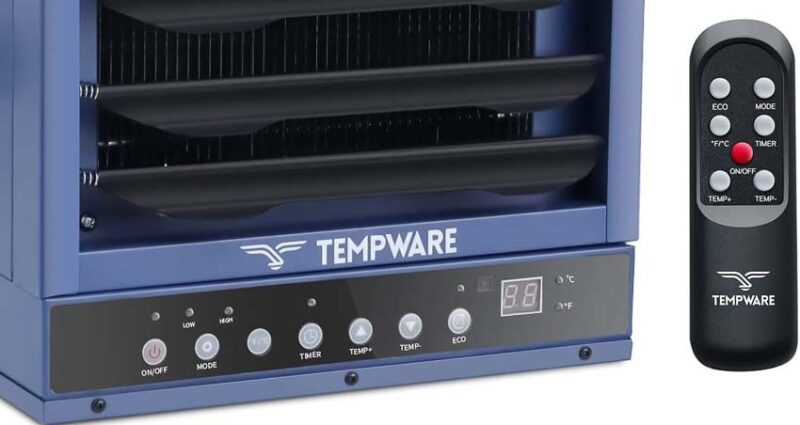
User-friendly operation should be a factor when choosing a garage heater. It shouldn’t take you more than a few seconds to set the garage heater to your desired temperature or output. Digital gauges, simple push-button activation, and even app-based controls make setting and controlling the different functions easy.
Advantages of Using a Garage Heater
Garages are often multi-functional spaces, so there are a lot of benefits to adding a heater. The following are some of the most common ways to put these tools to good use.
Create a Continuous Workspace and/or Added Storage
Depending on where you live, a garage can be downright unbearable during the winter months. Nevertheless, the job must go on. A garage heater will enable you to continue fixing and building when the temperatures plummet. What’s more, it will protect sensitive equipment and supplies from freeze-related damage.
Now, a lot of folks use their garage as an extra living space. Whether it’s an office, a man cave, a craft room, or a play area, a garage heater makes these options feasible throughout the cold seasons. Of course, if you plan on converting the garage into a bedroom, there are better ways to heat the space once it’s insulated and closed in.
From a practical standpoint, a garage heater can be an effective safeguard against damaging winter conditions. For instance, they can prevent diesel vehicles from gelling, help thaw ice-caked snowblower augers, and protect your cordless equipment’s lithium-ion batteries. Similarly, those who use their garage for canned food storage don’t have to worry about their jars freezing and breaking.
Safety Considerations When Using a Garage Heater
Safety should always be your first concern when it comes to introducing heat to a garage space (or any space in your house for that matter). Here are some need-to-know facts.
Proper Installation
When installing a garage heater, the surface supporting it must be sturdy and stable. For instance, placing a portable heater on a workbench is a much better idea than perching it on a wood pile. Also, heaters that attach to ceilings or walls should be secured to the studs behind the drywall or driven into the concrete with the appropriate hardware.
If you choose a natural gas unit, hire a licensed plumber to run a gas line and install the ventilation system.
Safe Placement
Wherever you place a garage heater, it needs to be far enough away from flammable or combustible items. Gas tanks, fabrics, solvents, paints, wood, cardboard, paper, and other items should be at least three feet from the heater (preferably five).
Regular Maintenance and Checks
Periodic Inspection for Wear and Tear
Periodically check your garage heater for wear and tear. Check any power cords for fraying, inspect the vent pipe for cracks, and ensure that the brackets holding the garage heater in place are secure. If there are any filters, be sure to check them and clean them as well. Once a month is typically fine during the heating season.
Timely Repairs and/or Part Replacements
As a rule, don’t repair your garage heater. If there is something wrong, it’s best to have it serviced by a professional or replace it completely. Also, don’t use a garage heater if you know there is something wrong with it. Unplug the device or shut the breaker and gas off to ensure that it’s safe until you can get it fixed.
Safe Operation Practices
Obey Manufacturer Guidelines
Before starting or using a garage heater, it’s important to read the manufacturer’s guidelines and instructions. But not only should you read them, you should stick to them. The manufacturer will outline the safest way to use the heater and anything else is not worth the risk.
Use the Safety Features
It’s also important to utilize any available safety features. Don’t attempt to circumvent switches or sensors. In fact, don’t modify the existing safeguards in any way. If your garage heater has WiFi and provides updates to a phone, set up the app to get as much information as possible. Stay in the know about how your device is running.
Frequently Asked Questions About Garage Heaters
How can I determine the best size of the garage heater for my space?
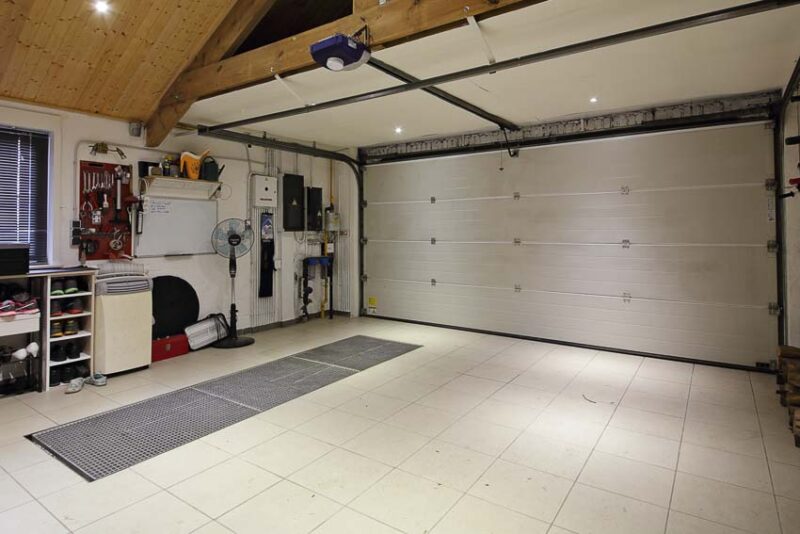
There are some fairly involved equations you can use. They involve finding the cubic area of the garage, understanding the insulation value in the walls and ceiling, and comparing it to where you live in the country. However, this is a simpler, less encompassing guide:
| Garage Size | Recommended BTU |
| 1-Car | 15,000 to 25,000 BTU |
| 2- to 2.5-Car | 30,000 to 45,000 BTU |
| 3-Car | 45,000 to 60,000 BTU |
Are electric garage heaters safer than propane ones?
Propane garage heaters, as well as natural gas heaters, use combustible gases and create exhaust fumes that can cause carbon monoxide poisoning. Electric heaters don’t produce gas. However, both can cause fires if used inappropriately.
Can I install and set up a garage heater by myself?
It depends on the heater. Many large garage heaters need to be hardwired into 220v circuits, and this is a job that most regions require an electrician to perform. The same applies to natural gas heaters, which require a plumber to install. However, if you already have a heater that you’re replacing, you may be able to handle the job yourself.
What safety features should I look for in a garage heater?
Safety features should include low-oxygen cut-off switches that will shut down the fuel if the unit detects that there isn’t enough oxygen to safely burn the fuel. Also, overheat switches that shut the unit off if it gets too hot are great features. For portable models, look for tip-over switches to keep the garage safe if the heater accidentally falls over.
How often should I perform maintenance checks on my garage heater?
Give your garage heater a lookover about once a month during the heating season to ensure that it’s safe and not touching anything. In-depth servicing should occur once per year.
Why You Can Trust Pro Tool Reviews
Ever check out a “review” site and you can’t tell if they actually tested anything or if they’re just “recommending” the Amazon top sellers? That’s not us. We won’t recommend anything unless we’d actually use it ourselves, and we don’t really care who the primary retailer is. It’s all about giving you a legitimate recommendation and our honest opinion of each product.
We’ve been in business since 2008 covering tools, writing reviews, and reporting on industry news in the construction and lawn care industries. Our Pro reviewers work in the trades and have the skills and experience to know whether tools can perform well in the field.
Each year, we bring in and review more than 350 individual products. Our team will put our hands on hundreds of additional tools at media events and trade shows throughout the year.
Pro Tool Reviews consults with innovators in the technology and design of tools to gain a broader grasp of where these products fit and how they work.
We work with more than two dozen professional contractors around the United States who review products for us on real job sites. We consult with them extensively on testing methods, categories, and practical applications.
Our site will provide more than 500 pieces of new content this year absolutely free for our readers. That includes objective evaluations of individual tools and products.
The end result is information you can trust because of the editorial, scientific, and real-world professional experience we collectively utilize each and every time we pick up and test a tool.






